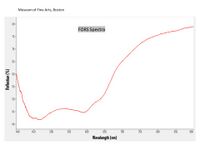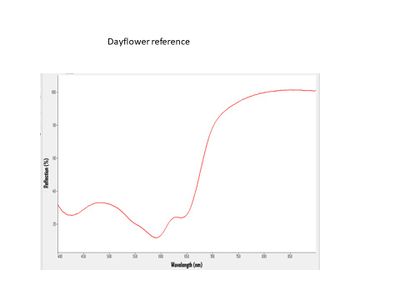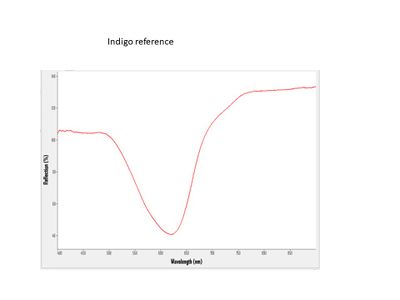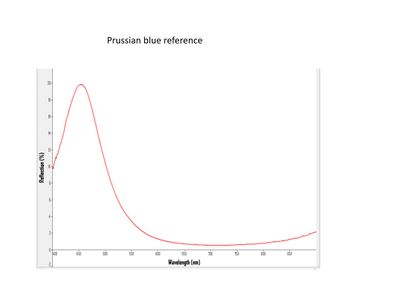Dayflower: Ukiyo-e colorant
Dayflower 青花 (aobana): A blue dye extracted from the petals of Commelina communis var. hortensis (大帽子花 ōbōshibana) better known as aobana. It is cultivated from the Asiatic dayflower (Commelina communis) or tsukusa (露草) to produce a larger petal to yield more dye. The dye is brushed onto Japanese paper, which acts as the vehicle to retain a concentrated dye as well to prevent the oxidation of the dye. The dayflower dyed paper is known as aobanagami (青花紙) or aigami (藍紙). The blue colorant in dayflower is primarily commelinin. In addition to its use as a colorant in Japanese woodblock prints, it was commonly used to draw the underdrawing in yūzen dyeing. Dayflower and dayflower dyed paper was grown and made in Kusatsu, Japan, and continues to be made there today but only three farmer/producers remain.
Dayflower along with indigo are the two blues used in Japanese woodblock prints before Prussian blue entered the palette in the 1830s. Dayflower can appear bluish gray to greenish yellow to tan depending on its state of preservation. Highly water soluble, dayflower was frequently the last color to be printed. Its solubility also presented a special challenge to the printer since this feature makes it difficult to print uniform and sharply defined edges of design. Despite these challenges, dayflower appears to have been used more often than indigo.
Dayflower is also frequently mixed with a red extracted from safflower to produce a variety of purples. Dayflower with turmeric through mixing or overprinting to produce greens are often found in early prints of two to three colors.
For additional information see: Dayflower, Uemura Dye Archive: Dayflower 269, 270, 271, Commelina communis (Kew)
Examples of Dayflower in Ukiyo-e Prints
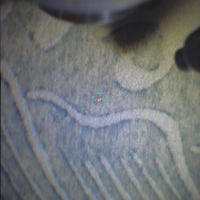
|

|

|

|

|
Analysis
Fiber optic reflectance spectroscopy (FORS) can easily identify the three blues: dayflower, indigo, and Prussian blue.
Images of Dayflower
List of Prints
Below is a list of prints where dayflower was detected.
Pages in category "Dayflower: Ukiyo-e colorant"
The following 52 pages are in this category, out of 52 total.
B
- Kiyonobu I, Actor Ôtani Hiroji I as the Candy-seller Kokusen-ya, 11.13165
- Bunchō, Actor Ichimura Uzaemon IX as Yoshiie, 34.333
- Bunchō, Actor Matsumoto Kôshirô III as Soga no Gorô, 11.18479
- Bunchō, Actor Segawa Kikunojô II, 06.1037
- Bunchō, Actors Nakamura Matsue I as Umegawa and Ichikawa Komazô II as Yoemon, 11.19316
E
H
- Harunobu, Beautiful Women of the Yoshiwara, Combing hair (2006.1537.1)
- Harunobu, Ebisu and Ofuji, from the series The Seven Gods of Good Fortune in the Modern World, 34.343
- Harunobu, Kojima Bingo no Saburô Takanori, 11.19633
- Harunobu, Nishikigi of the Kanaya Lighting Incense beside a Mosquito Net, 11.16479
- Harunobu, Parody of the Three Evening Poems: Teika, Jakuren, and Saigyô, 11.19703
- Harunobu, The Eleventh Month, from an untitled series of Twelve Months, 11.20120
- Harunobu, The Sake Cup, sheet 4 of the series Marriage in Brocade Prints, the Carriage of the Virtuous Woman, known as the Marriage series, 11.19475
- Harunobu, The Tenth Month, from an untitled series of Twelve Months, 11.20124
- Harunobu, Young Man Playing a Shakuhachi, 21.4677
- Harunobu, Young Woman Riding a Turtle (Parody of the Story of Urashima Tarô), 21.4594
- Harunobu, Young Woman Tuning a Shamisen, 06.479
- Hokusai, Woman, Child, and Man with Kite, from the series A Collection of Dances, 11.16764
K
- Kiyomasu II, Actor Segawa Kikunojô I in Momo Chidori Musume Dôjô-ji, 06.423
- Kiyomasu II, Actors Tamazawa Saijirô as the Courtesan Chidori and Ichimura Manzô as Takigô Tôshichi; Calendar for 1744, 21.5455
- Kiyomasu II, The Arrival of the Elephant, 58.343
- Kiyomitsu I, Actor Ichikawa Danzô III as Adachi Hachirô, 11.19030
- Kiyomitsu I, Actor Segawa Kikunojô II as Itsuki, 11.19020
- Kiyomitsu I, Actors Segawa Kikunojô II as the Courtesan Katsuragi and Ichimura Uzaemon IX as Nagoya Sanza, 45.832
- Kiyomitsu I, Actors Ôtani Hiroji III as Okabe no Rokuyata and Nakamura Sukegorô II as Inomata no Koheiroku, 46.1409
- Kiyomitsu I, Yoritomo's Hunt at the Foot of Mount Fuji, 11.19694
- Kiyonaga, The Brine Maidens, from the series Current Manners in Eastern Brocade, 11.13880
- Kiyonaga, The Brine Maidens, from the series Current Manners in Eastern Brocade, 21.5610
- Komatsuken, Courtesan Parading with Two Kamuro, 11.19711
- Koryusai, Descending Geese at Mimeguri, from the series Fashionable Eight Views of Edo, 11.14627
- Koryusai, Twilight Snow of the Bride, from the series Eight Views of Fashionable Human Relations, 11.19541
- Kunisada, Actor Nakamura Utaemon III as the Monkey Trainer Yojirô, from the series Great Hit Plays, 11.15095
- Kunisada, Actor Sawamura Tanosuke II, from the series Actor Rebuses, 11.42324
- Kunisada, Actors Iwai Kumesaburô II as Agemaki (R), Ichikawa Danjûrô VII as Sukeroku (C), and Onoe Kikugorô III as Shinbei (L), 21.7532-4
- Kunisada, Komurasaki of the Kado-Tamaya, kamuro Kochô and Sayuri, from the series Comparison of Beauties of the Pleasure Quarters, 11.20991
- Kunisada, Moon Viewing at Mukôjima, a Triptych, from the series Moon, Snow and Flowers, 11.15216
- Kuniyoshi, Ruan Xiaowu, the Short-lived Second Son, from the series One Hundred and Eight Heroes of the Popular Shuihuzhuan, 64.800
- Kuniyoshi, The Ninth Hour: Noon; Woman Playing with Cat, Fishmonger and Dog, from the series Sundial of Modern Tradesmen, 11.15955
S
- Shinsai, Chapters 16–18, from the series The Tale of Genji, 11.21066
- Shunkō, Actors Ichikawa Danjûrô V as Fukurokuju, Iwai Hanshirô IV as Ryûyô Dôji, and Sawamura Sôjûrô III as Shin'yô Dôji, 11.14971
- Shunkō, Actors Nakamura Nakazô I and Ôtani Hiroji III, 11.2014
- Shunshō, Actor Segawa Kikunojô III as Shirokiya Okoma, from the series Fans of the East, 11.14871
- Shunshō, No. 3, Comparative Poems, from the series Six Types of Waka Poetry as Described in the Preface of the Kokinshû, 11.19295
- Shunshō, No. 6, Cui Zongzhi (Saisôshi), from the series Eight Immortals of The Wine Cup, 11.14847

